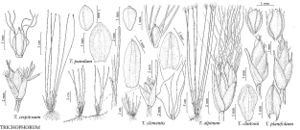Trichophorum clintonii
Novon 5: 102. 1995.
Plants densely cespitose; rhizomes absent. Culms trigonous, 7.5–36 cm, scabrous proximal to inflorescence. Leaves: basal sheaths orange to dark brown; distal leaf sheaths truncate to concave at mouth; blades (6–)15–250 × 0.5–0.8(–1) mm, equaling or shorter than culms at flowering, much shorter than culms at fruiting. Inflorescences: spikelets 3–6-flowered, 3.4–5.3 × 1.3–2.5 mm; bracts shorter than to slightly exceeding spikelets, 3–6 mm, apex mucronate or awned, awn to 1.4 mm. Spikelets: scales orange-brown to dark brown, midribs not reaching apices in distal scales, apex obtuse. Flowers: perianth bristles 3–6, pale brown, terete, equaling or shorter than achenes, scabrous; anthers 0.7–1.5 mm. Achenes compressed trigonous, 1.5–2 × 1–1.2 mm.
Phenology: Fruiting late summer (May–Jul).
Habitat: Open, dry to mesic prairies, meadows, riverbanks, rock outcrops, on lime-rich substrates
Elevation: 10–900 m
Distribution

Alta., N.B., Ont., Que., Sask., Maine, Mich., Minn., N.Y., Wis.
Discussion
Selected References
None.
